Mount Holyoke Alumna Embraced Both Parts of Her Cultural Identity
Ruth Muskrat Bronson, class of 1925, belonged to two different worlds. Her father was Cherokee, and she was raised in a Cherokee community in the Oklahoma territory. She was also exposed to white culture by her Irish mother, even if only through stories. From a young age, Bronson identified with both cultures, and she didn’t want to choose between the two.
So she didn’t.
Bronson believed diversity could enrich both individuals and communities. As a result, she embraced both parts of her cultural identity and encouraged other Native Americans to do the same.
Defying the Odds
While Bronson’s racial background was not uncommon, her pursuit of higher education was. Not many Native Americans, and particularly Native American women, went to college. Mount Holyoke’s first students of Cherokee lineage were Elinor Boudinot, class of 1846, and Mary Boudinot, class of 1849. And Smith College graduated its first Native American student, Angel De Cora, in 1896.
Bronson set out on a path different than that of her peers. After high school, she worked for the YWCA on an Apache reservation, took classes at the University of Oklahoma and the University of Kansas, and lectured around the country about Native American affairs. She also represented Native American students at the World’s Student Christian Federation Conference in China in 1922; according to one account, she was the “poet delegate.” Her impressive resume earned her a full scholarship to Mount Holyoke.
Bronson arrived in South Hadley at age twenty-five as one of a limited number of students admitted with advanced standing. She entered as a junior.
A Supportive Environment
Her transition to life at Mount Holyoke wasn’t exactly seamless, according to Bronson’s friend and classmate Harriet Stoddard, class of 1925, who had also transferred. “Ruth Muskrat gets so discouraged over things here,” Stoddard told her parents in a letter dated November 18, 1923. “She was almost on the point of giving up and going back to Nebraska last week. She has to make up Latin for entrance credit and she finds chemistry awfully hard.”
But soon Bronson was making plans to hike Bear Mountain with friends and forging connections with her professors. As her letters show, she loved meeting informally with her teachers in the evenings to enjoy a cup of tea and good conversation.
“It might not have meant so much to some other girls who have had such opportunities all their life, but to me it was the opening up of a whole new world of joy and beauty and womanliness,” she wrote in a letter that appeared in the Mount Holyoke News on May 14, 1926.
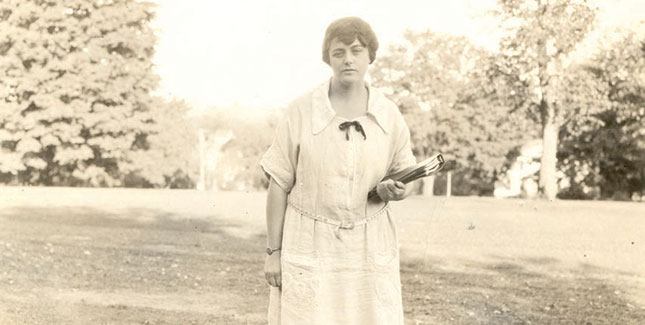
An undergraduate Ruth Muskrat stands on Skinner Green with books in hand. Photo courtesy of MHC Archives & Special Collections
Bronson also developed a special relationship with her English professor, Miss Snell. A former Lyon herself with a master’s from Yale and a doctorate from the University of Michigan, Ada Snell, class of 1892, embodied the type of accomplished faculty that President Mary Woolley wanted at the College. Upon Snell’s retirement in 1938, she was remembered for her ability to spark students’ interest in poetry, a subject Bronson already found appealing. Rather than forcing her to reject her Cherokee heritage like other teachers had done, Snell encouraged Bronson to tap into and celebrate that heritage in writing assignments.
Even Stoddard noted the effect Snell had on Bronson. In a January 1924 letter home to her parents, she wrote, “She [Miss Snell] has succeeded in working Ruth Muskrat into ‘Indian’ tunes and images—fancy that. Making an Indian write natural instead of a la Tennyson—Well!—”
With a natural gift for language and a newfound support for expressing herself, Bronson declared English as her major. She also studied sociology.
A Way with Words
At the same time she was pursuing a European-American-style education, Bronson held tightly to her Native American background. While she was a student, she educated the local community and even national leaders on Native American affairs. In fact, while most students were making plans for the winter recess in December 1923, Bronson was contemplating how she should greet President Calvin Coolidge.
She had been invited to the White House as part of the Committee of One Hundred, a group designed to advise on Native American policy. Bronson was there representing Native American students. For the occasion, she intentionally wore ceremonial Native American regalia that included a white buckskin dress, beaded moccasins, a headband, and a leather belt with large silver medallions—all of which had been made by Cheyenne and Apache women.
We want to make our own unique contribution to the civilizations of the world—to bring our own gifts to the altar of that great spiritual and artistic unity which such a nation as America must have.Ruth Muskrat Bronson, class of 1925
The same woman who made her dress also created an intricately beaded cover for the book Bronson presented to the “Great White Father,” as she called Coolidge. The Red Man in the United States, written by G.E.E. Lindquist, was a study of the social, religious, and economic life of Native Americans. Bronson also delivered a speech that proposed a way forward.
“We want to understand and to accept the civilization of the white man; we want to become citizens of the United States and to share in the building of this great nation that we love,” she told Coolidge. “But we want also to preserve the best that is in our own civilization. We want to make our own unique contribution to the civilizations of the world—to bring our own gifts to the altar of that great spiritual and artistic unity which such a nation as America must have. This is the Indian problem which we who are Indians find ourselves facing.”
After Bronson’s presentation, the former governor of Massachusetts invited her to have lunch with him and the First Lady. On June 2, 1924, Coolidge signed the Indian Citizenship Act, granting automatic American citizenship to Native Americans born in the US.
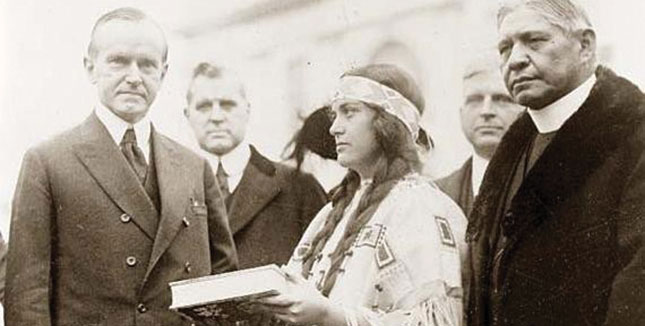
In a 1923 meeting at the White House, Bronson presents President Calvin Coolidge (left) with a book of Native American history. Reverend Sherman Coolidge is pictured on the right. Photograph retrieved from the Library of Congress
“Indians Are People Too”
Shortly after becoming the first Native American to graduate from Mount Holyoke, Bronson accepted a position teaching junior high school English in Kansas at the Haskell Institute (now Haskell Indian Nations University), the largest Native American boarding school in the country. Her students came from nearly sixty different tribes. In addition to her classroom teaching, Bronson sponsored the eighth- grade class, served as advisor for a literary society, and taught Sunday school.
The Haskell Institute was different from other government boarding schools because it was run by Native Americans, allowing the teachers to weave Native American culture into lessons. Bronson took full advantage.
In her memoir Essie’s Story: The Life and Legacy of a Shoshone Teacher, former student Esther Burnett Horne recalled, “Ruth always tried to make the subject matter come alive for us, and she always tried to bring some of our culture into the literature that she taught. When she taught Longfellow’s ‘Evangeline,’ she wove in some of the history and even some of the legends of the Indian people who lived in the different areas that Evangeline moved through in her wanderings. . . . It made the readings so much more relevant to our understanding of who we were.”
Bronson also taught her students to have “a healthy respect for themselves as individuals and a pride in their heritage,” Horne wrote. “When Ruth would tell us to have pride in who we were, she’d say, ‘Indians are people, too. Don’t forget that.’”
At the same time, Bronson replicated some of the experiences she had enjoyed at Mount Holyoke. By sprucing up her living quarters and inviting the girls to friendly gatherings, she made it possible for students to get to know faculty. The opportunity for these students to leave their teepees, adobe houses, and dormitories and spend time in “a pretty room,” Bronson said, was significant.
Bronson also taught her students to have “a healthy respect for themselves as individuals and a pride in their heritage.”Esther Burnett Horne
Bronson attributed her interest in celebrating her students to her college experience. “I care more about what happens to the inner selves of these boys and girls than I did before,” she wrote in her May 1926 letter. “Somehow out of my two years at Mount Holyoke I learned to care more for the individual and to respect personality.”
Bronson was awarded the Henry Morgenthau Prize for making the best use of her college education during the first year after graduation.
Her personal life also flourished around this time. In 1928 she married John Bronson, who supported his wife’s work throughout their relationship.
A Distinguished Career
After leaving the Haskell Institute, Bronson continued to build a career focused on bettering the lives of Native Americans and helping them reach their full potential as leaders in both their tribal communities and the larger US society.
In 1931 she began working for the Bureau of Indian Affairs. Initially, she was based in Kansas City as a guidance and placement officer for boarding school graduates in eight Plains states. In 1936 she moved to Washington, DC, to head up the scholarship and loan program. Bronson had long believed that scholarships were a crucial need of Native American youth. During her tenure, she helped send more than two thousand Native Americans to college.
In 1943 Bronson stopped working to spend more time with John and their five-year-old daughter, Dolores, whom the couple had adopted a few years earlier, but she continued to advance her cause in other ways. She published Indians Are People, Too, an educational text designed for Native American students, and helped to establish the National Congress of American Indians as a unified voice of tribal nations, serving for a time as the organization’s executive secretary. Still in existence today, the nonprofit successfully lobbied for passage of the HEARTH Act of 2012, which allows for tribal self-determination in land leasing and economic development decisions.
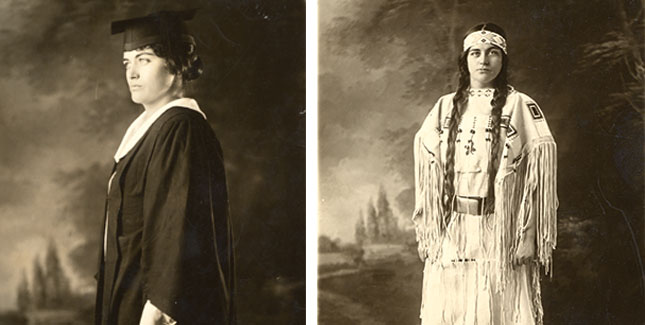
Left: Ruth Muskrat in her graduation robe at Mount Holyoke commencement; Right: Bronson wearing the ceremonial regalia that was designed for her meeting with President Calvin Coolidge. Photos courtesy of MHC Archives & Special Collections
Once Dolores was grown, Bronson returned to the workforce as a health education specialist for the Indian Health Service, a division of the Department of Health and Human Services. In this new role, she was able to work directly with the people of the San Carlos Apache Reservation in Arizona, sharing information about health hazards and hygiene. For her work she received the Oveta Culp Hobby Service Award, the government’s highest civilian award at the time.
Bronson left government service in 1962 and joined Save the Children USA, a charity devoted to helping impoverished youth. First as a volunteer and then as a staff member, serving for a time as national program chairman, she worked with Native American tribes in Arizona on community development projects until her retirement ten years later.
The First but Not the Last
Along with her professional accomplishments, Bronson counted among her achievements the enrollment of three more Native Americans at Mount Holyoke in the two decades after she graduated. Ensuring another Native American received the same caliber of education she had became a goal of Bronson’s during her early years at the Haskell Institute.
“I’m going to bend all the energy I have to send another Indian girl to Mount Holyoke, and I shall never be satisfied until some other girl of my people can have the same great experience that was mine when I went there,” Bronson wrote in 1926. She didn’t have to wait long to see this happen.
Less than two years later Verna Nori, class of 1932, of the Laguna Pueblo enrolled in the College. While she was a student, Nori represented Mount Holyoke and Native Americans at three international conferences. After graduating, she became president of the Government Day School for Indians in New Mexico. Another Native American, Evelyn Yellow Robe, class of 1942, reportedly received a scholarship from the Bureau of Indian Affairs while Bronson was in charge of the program. Following graduation from Mount Holyoke, Yellow Robe worked as a speech instructor for a few months at the College. She went on to earn a master’s and a doctorate in speech pathology from Northwestern University, taught at Vassar College, and became internationally known in the field of speech pathology, having settled in Germany with her husband, Dr. Hans Finkbeiner.
I’m going to bend all the energy I have to send another Indian girl to Mount HolyokeRuth Muskrat Bronson, class of 1925
Yellow Robe, who was raised in the Lakota tradition—part of a confederation of seven Sioux tribes— was selected in 1948 to appear in the second edition of Indians of Today, a book published by the activist group Indian Council Fire. Bronson wrote the foreword.
Following Bronson’s lead, these Native American women embraced a multicultural, blended worldview. In doing so, they proved that they could contribute to society and become leaders because of, rather than in spite of, their backgrounds. As Bronson noted in her book Indians Are People, Too, “Under the right kind of circumstances this blending can build for the individual a more satisfying life and for the world a richer personality than any one culture could produce.”
—By Erin Binney
Erin Binney is a freelance writer and editor based in western Massachusetts.
A similar article appeared in as “The Best of Both Worlds” in the winter 2018 issue of the Alumnae Quarterly.
January 11, 2018








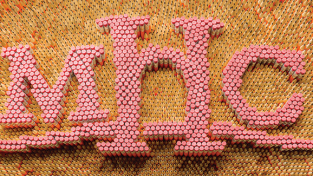
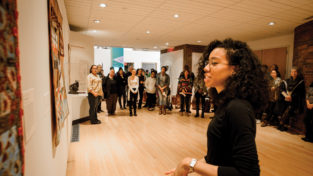

Ruth is my great great aunt. She is my guide and role model in every way. My child was born October 3rd… I wonder if Ruth’s spirit is in my little one now. Thank you, Holyoke, for being a beautiful part of my aunt’s life, and my heritage.
Wado. Donadagohvi.
Jade